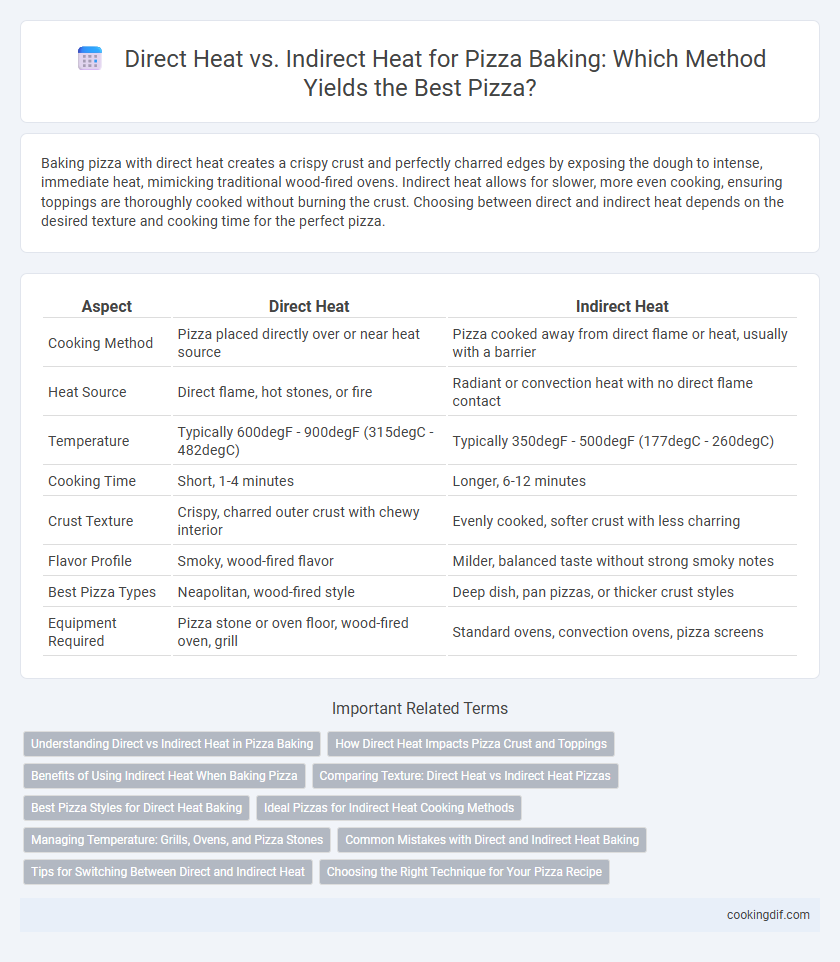Baking pizza with direct heat creates a crispy crust and perfectly charred edges by exposing the dough to intense, immediate heat, mimicking traditional wood-fired ovens. Indirect heat allows for slower, more even cooking, ensuring toppings are thoroughly cooked without burning the crust. Choosing between direct and indirect heat depends on the desired texture and cooking time for the perfect pizza.
Table of Comparison
| Aspect | Direct Heat | Indirect Heat |
|---|---|---|
| Cooking Method | Pizza placed directly over or near heat source | Pizza cooked away from direct flame or heat, usually with a barrier |
| Heat Source | Direct flame, hot stones, or fire | Radiant or convection heat with no direct flame contact |
| Temperature | Typically 600degF - 900degF (315degC - 482degC) | Typically 350degF - 500degF (177degC - 260degC) |
| Cooking Time | Short, 1-4 minutes | Longer, 6-12 minutes |
| Crust Texture | Crispy, charred outer crust with chewy interior | Evenly cooked, softer crust with less charring |
| Flavor Profile | Smoky, wood-fired flavor | Milder, balanced taste without strong smoky notes |
| Best Pizza Types | Neapolitan, wood-fired style | Deep dish, pan pizzas, or thicker crust styles |
| Equipment Required | Pizza stone or oven floor, wood-fired oven, grill | Standard ovens, convection ovens, pizza screens |
Understanding Direct vs Indirect Heat in Pizza Baking
Direct heat in pizza baking involves placing the pizza close to the heat source, such as a wood-fired oven or grill, which creates a crispy crust and rapid cooking in minutes. Indirect heat uses a heat source positioned away from the pizza or with a barrier, providing slower, more even cooking that prevents burning and allows for cheese melting and proper toppings cooking. Mastering the balance between direct and indirect heat ensures optimal texture and flavor, with direct heat focusing on crust development and indirect heat perfecting topping doneness.
How Direct Heat Impacts Pizza Crust and Toppings
Direct heat in pizza baking creates a crispy, charred crust by rapidly searing the dough, locking in moisture and enhancing flavor through caramelization and Maillard reactions. Toppings cook quickly but remain vibrant, with cheese melting evenly and vegetables retaining slight crunch. This method also intensifies smoky and toasted notes, delivering an authentic wood-fired pizza experience.
Benefits of Using Indirect Heat When Baking Pizza
Using indirect heat for baking pizza ensures even cooking and prevents burning the crust by avoiding direct exposure to intense flames. This method enhances dough texture, allowing it to rise properly while maintaining a crispy exterior. Indirect heat also provides more control over cooking temperature, resulting in a perfectly baked pie with balanced toppings and melt-in-your-mouth cheese.
Comparing Texture: Direct Heat vs Indirect Heat Pizzas
Direct heat pizza baking produces a crispy, charred crust with a slightly smoky flavor due to high temperatures directly contacting the dough, perfect for Neapolitan-style pizzas. Indirect heat yields a softer, more evenly cooked crust with less charring, often preferred for thick or deep-dish pizzas that require longer baking times. The choice between direct and indirect heat significantly impacts pizza texture, balancing crispiness against tenderness.
Best Pizza Styles for Direct Heat Baking
Direct heat baking produces a crisp, charred crust ideal for Neapolitan and New York-style pizzas, which benefit from the intense, quick cooking process. The high temperatures, often reaching 800-900degF, create the signature leopard spotting and airy texture characteristic of these pizza styles. Thin-crust varieties thrive under direct heat, ensuring a balance of crunchy edges and perfectly melted toppings.
Ideal Pizzas for Indirect Heat Cooking Methods
Indirect heat cooking methods are ideal for pizzas with thicker, doughier crusts such as deep-dish or stuffed pizzas, as they allow the interior to cook thoroughly without burning the exterior. This slower, more even heat distribution helps melt cheese uniformly and develop rich toppings while maintaining a soft, chewy base. Pizzas with abundant toppings or delicate ingredients also benefit from indirect heat to prevent overcooking or charring.
Managing Temperature: Grills, Ovens, and Pizza Stones
Managing temperature with direct heat exposes pizza dough to intense flames or heating elements, creating a crispy crust with characteristic char marks, ideal for wood-fired grills or brick ovens. Indirect heat involves positioning the pizza away from direct flames or using a pizza stone to evenly diffuse heat, preventing burning and ensuring thorough cooking of toppings and cheese. Utilizing a pizza stone in ovens absorbs and radiates heat steadily, offering optimal temperature control for consistent, evenly baked pizza results.
Common Mistakes with Direct and Indirect Heat Baking
Common mistakes with direct heat baking include burning the pizza crust due to excessive surface temperature and uneven cooking that leaves the center undercooked. In indirect heat baking, a frequent error is insufficient heat intensity, resulting in a soggy crust and lack of proper caramelization. Proper temperature management and positioning are crucial for achieving a balanced bake whether using direct or indirect heat methods.
Tips for Switching Between Direct and Indirect Heat
Switching between direct and indirect heat for pizza baking requires careful temperature control to achieve the perfect crust and evenly cooked toppings. Use direct heat for a crisp, charred base by placing the pizza close to the flame or heating element, and switch to indirect heat to prevent burning while allowing the cheese and toppings to melt thoroughly. Adjust oven racks or move the pizza to a cooler zone when shifting methods, and monitor cooking times closely to maintain optimal texture and flavor.
Choosing the Right Technique for Your Pizza Recipe
Direct heat baking uses high temperatures from below, ideal for thin-crust pizzas that require quick cooking and a crispy base. Indirect heat, often achieved through convection or by placing the pizza away from the direct flame, suits thicker or stuffed crust pizzas, allowing even cooking without burning. Selecting the right heat method depends on dough thickness, toppings, and desired texture to achieve optimal flavor and crust quality.
Direct heat vs indirect heat for pizza baking Infographic

 cookingdif.com
cookingdif.com